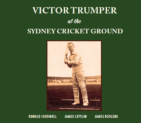Bookie Gambler Fixer Spy
Archie Mac |Published: 2012
Pages: 232
Author: Hawkins, Ed
Publisher: Bloomsbury
Rating: 4 stars

This was the Wisden book of the year in 2015 and while I always like to read the winner, at the time I just didn’t want to know about match fixing. Rumours of cricket fixes were rife around the time Bookie Gambler Fixer Spy (BGFS), was released. The fallout from the 2010 The News of The World spot betting scandal was still being felt and it was reaching the stage where if a catch was dropped in an international match you’d hear the call of “fix!”
It seems I was right to avoid this book back in 2012 for fear it would ruin my experience of enjoying a cricket match. As Hawkins writes at the end of his book “I have caught the whispers and claims of too many teams, matches and players to be able to sit in a stadium or in front of a television and not, in the words of Lord Condon (the first director of ICC’s anti-corruption unit), exclaim that must be moody”.
Once you have read BGFS, you will understand Hawkins jaded view of professional cricket. You will also understand how the betting system, especially in India, works. Hawkins quickly quashes the concept of spot betting and clearly makes the News of The World exposé a non betting story. That is no punters were making money on the sting, as any bookmaker who is going to stay in business would know there was a fix on. Hawkins certainly implies that Mohammad Amir, the young Pakistan bowler, was at worst naive and at best manipulated.
BGFS is almost like a whodunit, with Hawkins involved in shadowy meetings with bookmakers, a spy, gamblers and perhaps the odd fixer. The mystery he pursues from early on is whether the semi final in the 2011 World Cup between India and Pakistan was fixed. By the end of the book it is hard to argue that it wasn’t a fix as the evidence continues to build throughout Hawkins’ research.
There are other matches that Hawkins’ queries, as well as the integrity of the IPL and the county game. In the end he puts it back onto the players and rightly points out that without their cooperation the match fixers would struggle. Unfortunately, and as Hawkins demonstrates, there are always players, whether deliberately or unknowingly, doing the bidding of the betting fraternity.
As is usual with this type of book Hawkins does not name every player implicated in match fixing, although he does name more than you would perhaps expect, and almost every Test nation is represented. While the book is well written and always interesting it does after awhile start to wear you down, and as I feared does make you question the point of watching professional cricket.
I waited until 2017 to read this book as I didn’t want it to taint my enjoyment of watching the greatest game of all. Despite the wait I still feel uneasy and imagine I, just like Hawkins, will be now looking for subterfuge and skulduggery at every turn.






Leave a comment